The United States Department of Agriculture has divided the country into hardiness zones, which help gardeners determine which plants are the best ones for their climate. There are 13 zones, and they let you know what the average lowest temperature is in your part of the country. Some maps further divide the zones into “a” and “b” zones, but some do not. Maps of the contiguous United States don’t even have all 13 zones, since they stop at zone 11b or 12a at the very end of Florida. (You’ll find zone 13 in Puerto Rico).
The average lowest temperature in Zone 6a is -10 to-5 degrees Fahrenheit while the average lowest temperature in 6b ranges from -5 degrees to 0 degrees Fahrenheit. Zones 6a and b are mostly found in the middle of the country, though they can be as far north in the east as the coasts of New Hampshire and Maine and as far north in the west as the border Washington State shares with British Columbia. You’ll also find areas of Zone 6 in Michigan and western New York along the Great Lakes.
When it comes to shade, partial shade means that the area gets three to six hours of sun or shade every day. Full shade doesn’t mean total darkness! Few plants can survive in total darkness all day. Full shade just means that the area doesn’t get direct sunlight, even though it may be bright. Here are the best shrubs for Zone 6 shade gardens.
1. Drooping Leucothoe

This shade-loving shrub bears chains of fragrant white flowers.
©steve estvanik/Shutterstock.com
Despite its sad name, this shrub delights with its beautiful and fragrant white flowers that arrive in chains from gracefully arched branches. Because the leucothoe is an evergreen and its flowers and branches go all the way to the ground, it’s a good shrub to place before other plants that might lose their looks during the winter.
The drooping leucothoe grows from 2 to 6 feet tall with a similar spread. It thrives in well-draining, moist, cool, and acidic soil, and so is a good companion for rhododendrons and azaleas. The tiny, urn-shaped flowers also attract pollinators. Best of all, it loves shade, from partial to full, is easy to care for, and needs a medium amount of watering. Over time the plant grows suckers which turn into colonies. The shrub needs protection from wind and may need some winter protection in shade gardens in Zone 6a. This mainly involves mulching the area around the roots. It’s also a calcifuge, which means it can’t stand alkaline soil, so make sure the soil has the proper pH before you plant it.
2. Mountain Laurel

Mountain laurels are a beautiful addition to shade gardens.
©JayL/Shutterstock.com
This evergreen shrub, which grows from 5 to 15 feet tall with a 5 to 15 foot spread, is treasured for its beautiful and unusual flowers that arrive in May and cover the shrub. The flowers are in the form of hexagonal or pentagonal cups and are pink to rose to white with purple markings within. These markings are actually the anthers that are held against the petal and snap up when a bee lands on them, releasing pollen. Even when the flowers fade, the glossy, dark green, leathery leaves remain.
Plant the mountain laurel in moist, acidic, well-drained soil that’s been amended with rotted manure or compost. Make sure to remove the flowers right after they’re spent, and prune the shrub a bit to keep it from getting leggy. If the flowers aren’t removed, they become brown fruits that hang on the shrub all winter.
The mountain laurel is ideal as a foundation shrub but can also be planted in woodland shade gardens along with rhododendrons and azaleas. It only needs medium watering and care and can tolerate deer and rabbits. One thing to know about the mountain laurel is that all parts of it are toxic to humans and pets.
3. Oregon Grape-Holly
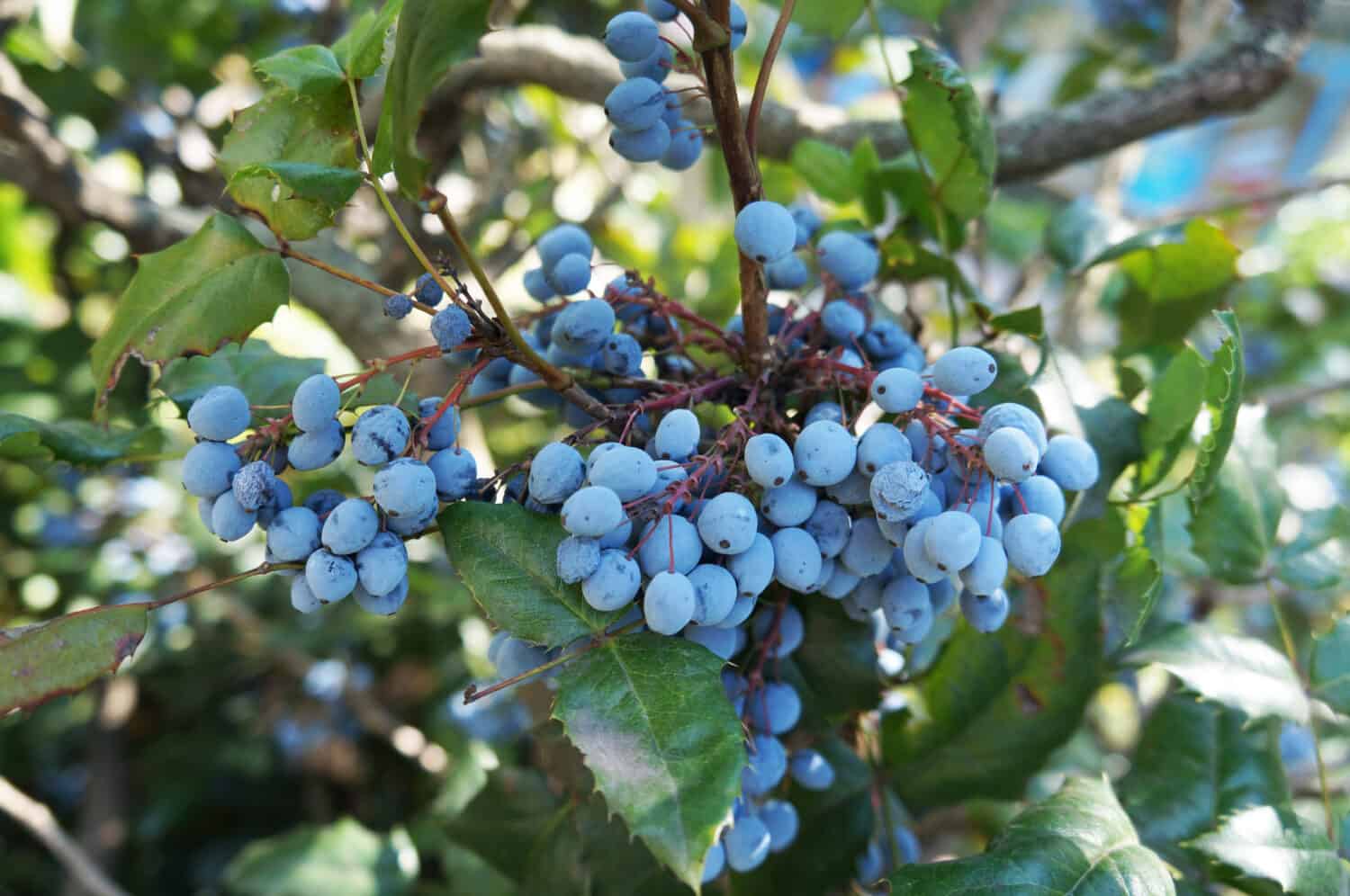
The Oregon grape-holly is a type of mahonia and has holly-like leaves and blue fruit.
©catus/Shutterstock.com
This shrub is a type of mahonia that, despite its common name, is native to Japan. Still, it does brilliantly in North American shade gardens. The shrub grows to a height of 5 to 7 feet and has a spread of 7 to 10 feet. It has compound, leathery, evergreen leaves that grow as long as 18 inches with 4 inch leaflets. The fragrant yellow flowers arrive in earliest spring and are followed by bunches of fruit that eventually turn blue-black by early summer. The fruit is eaten by birds and is even edible for humans.
Oregon grape holly grows best in part and even full shade and is easy to grow and maintain. It doesn’t need much water, though it appreciates acidic soil that’s well-draining and kept moist. It’s just the thing for a woodland garden, a shady border or a shady spot beneath a taller tree. The shrub forms colonies through suckering, so pull the suckers out if you don’t want it to naturalize.
4. Some Rhododendron and Azalea Species

Rhododendrons and azaleas are just right for shade gardens.
©Cvandyke/Shutterstock.com
Rhododendrons and azaleas grow well in a variety of hardiness zones, though some species are better for Zone 6 than others. These shrubs are known for their sensational, brilliantly colored flowers. Rhododendrons and azaleas are basically the same plant, though rhododendron flowers look like bells and the flowers of azaleas are more funnel-shaped. Rhododendrons are usually evergreen. Some azaleas are also evergreen, while others are deciduous.
Rhododendrons and azaleas flourish in well-drained, acid soil and love partial shade. Among the rhododendrons and azaleas that do well in Zone 6 are:
Carolina Rhododendron
This rhododendron is native to the Blue Ridge Mountains. It grows from 3 to 6 feet with dark green leaves. The flowers are white or pink and the shrub has a tidy round habit that makes it good for foundation plantings, groups and the edges of woodland gardens.
Rosebay Rhododendron
This rhododendron has lovely magenta or white flowers and grows from 4 to 15 feet in height. It’s native to North Carolina and needs some shade to grow well.
Torch Azalea
These azaleas get their name because of their red orange or salmon-colored flowers, though some have flowers that are rose-colored or white. The shrub can grow to 10 feet tall, and in Zone 6 the leaves probably take on some fall color. These azaleas can blossom in full shade, but partial shade is best.
Kurume Hybrid Azalea
These popular Japanese hybrids grow slowly but can reach 6 feet in height when they’re mature. They are often used as landscape shrubs and have glorious flowers in shades of pink and red.
5. Some Hydrangeas
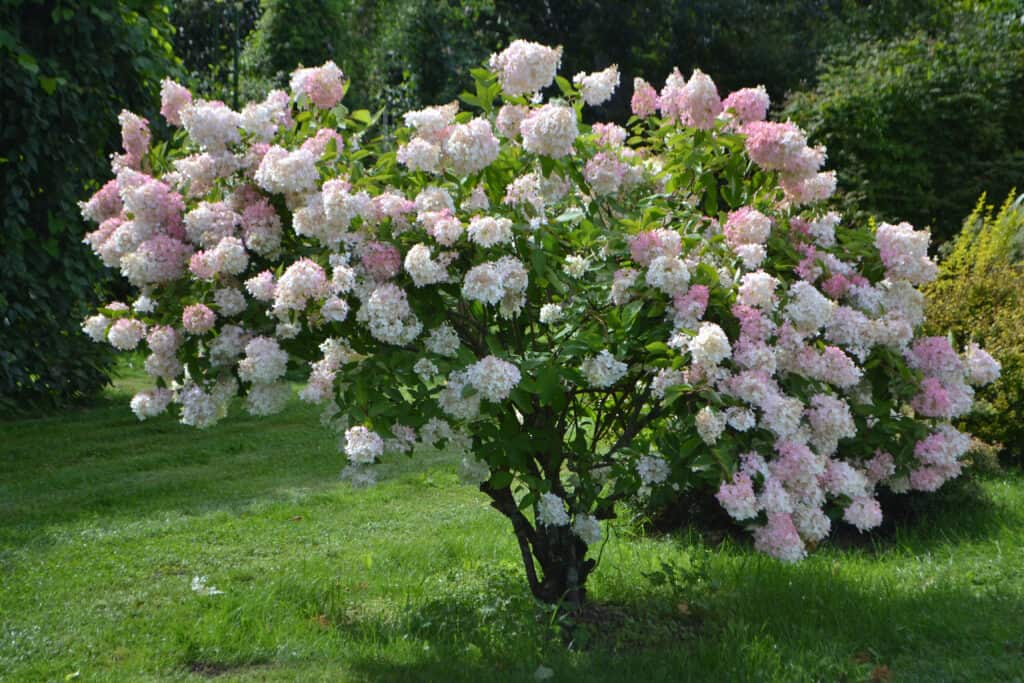
Some types of hydrangea thrive in Zone 6 shade gardens.
©Edita Medeina/Shutterstock.com
Hydrangeas are loved for their masses of flowers in shades of white, blue, or red. They also thrive in a range of hardiness zones, but the types that do well in Zone 6 are smooth hydrangeas, oakleaf hydrangeas, and panicle hydrangeas.
Smooth Hydrangeas
These hydrangeas have round clusters of cream-colored flowers that are 4 to 12 inches around. The plant grows to about 4 feet in height, and its leaves are large and green. The flowers, fresh or dried, are excellent for arrangements, and the shrub itself is good for group plantings or borders. Smooth hydrangeas are fast-growing plants that like fertile, moist but well-drained soil. They grow best in partial shade.
Oakleaf Hydrangea
As its name says, this hydrangea has leaves that resemble those of oak trees. Like oak tree leaves, they turn shades of burgundy and purple in the fall. Oakleaf hydrangeas can grow as much as 6 feet in height and 8 feet wide. When the leaves fall, the shrub’s shaggy bark provides winter interest. The flower heads can be a foot long and produce greenish-pink flowers. This hydrangea also does best in moist, fertile, well-draining soil, especially if it is acidic. It can do well in full shade, but its autumn colors are less intense, and it won’t flower as profusely.
Panicle Hydrangea
These are the largest of the hydrangeas that thrive in Zone 6. A panicle hydrangea can grow to 22 feet tall. The white, pink, or rust-colored flowers are borne in panicles that can be a foot long. They arrive in midsummer and last until fall. Sometimes their weight causes the branch they’re on to arch, which makes the shrub even more elegant and beautiful.
6. Common Winterberry
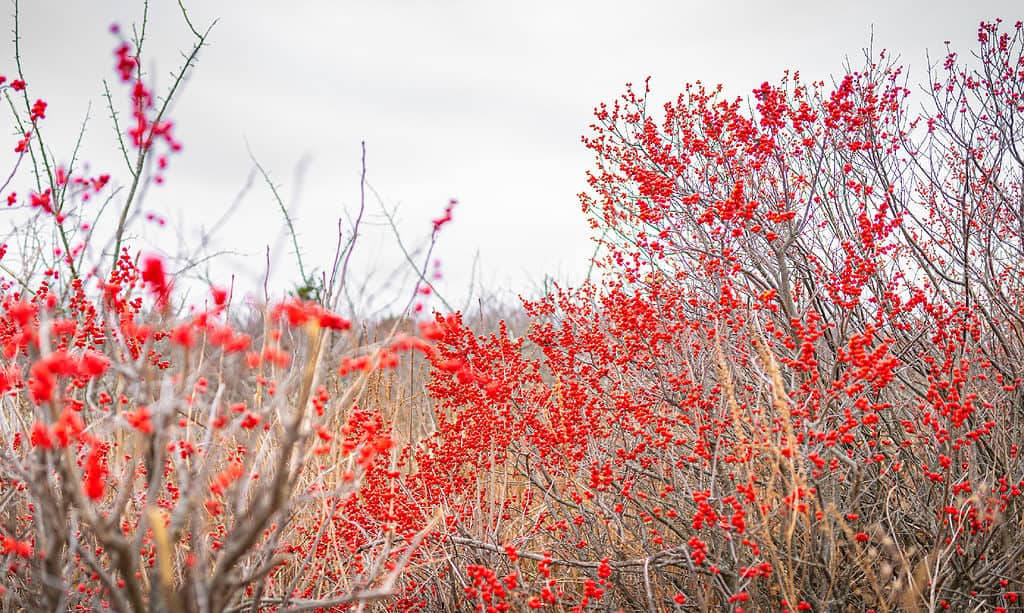
The winterberry not only thrives in shade gardens but in water gardens as well.
©iStock.com/Sanghwan Kim
The common winterberry is a deciduous shrub native to North America. It grows from 6 to 12 feet tall and has a similar spread, and its small, greenish-white flowers bloom in June and July. Its leaves are egg-shaped, dark green, toothed and from 2 to 3 inches long. An easy shrub to grow, common winterberry is good for both shade gardens and water gardens since it grows well in wet soil and partial shade.
The common winterberry’s selling point is the large red berries that cover the shrub starting in late summer and persist throughout the winter. If you want birds to visit your property, plant this shrub, for they can’t get enough of the berries. The one thing to know is that the common winterberry is dioecious. If you want the red berries, make sure to plant a male winterberry at most 15 feet from a female.
7. Inkberry

The evergreen inkberry plant also does well in shade gardens.
©Yingna Cai/Shutterstock.com
A relative of the common winterberry, this shrub gets its name because its fruit is black. It’s also unlike the common winterberry in that it is an evergreen. The inkberry is native to North American swampland, tolerates salt, and thrives in wet, fertile soil. This makes it a great shrub to grow by the ocean or any body of water. It’s cold hardy and thrives in partial shade. Young plants are compact, but the shrub can get a bit leggy as it matures. Fortunately, the inkberry responds well to even hard pruning.
The shrub grows from 5 to 8 feet tall and has a similar spread. Its flowers are like the winterberry’s in that they’re greenish-white and tiny, but bees love them and make a delicious honey from them. The leaves are flat, oval, glossy and dark green and about 1.5 inches long with teeth near the tops. Like the winterberry, the black berries hang on the shrub throughout the winter and feed the birds. Native Americans also made tea out of the berries, which gives the shrub its other name of Appalachian tea.
8. Shrubby St. Johnswort
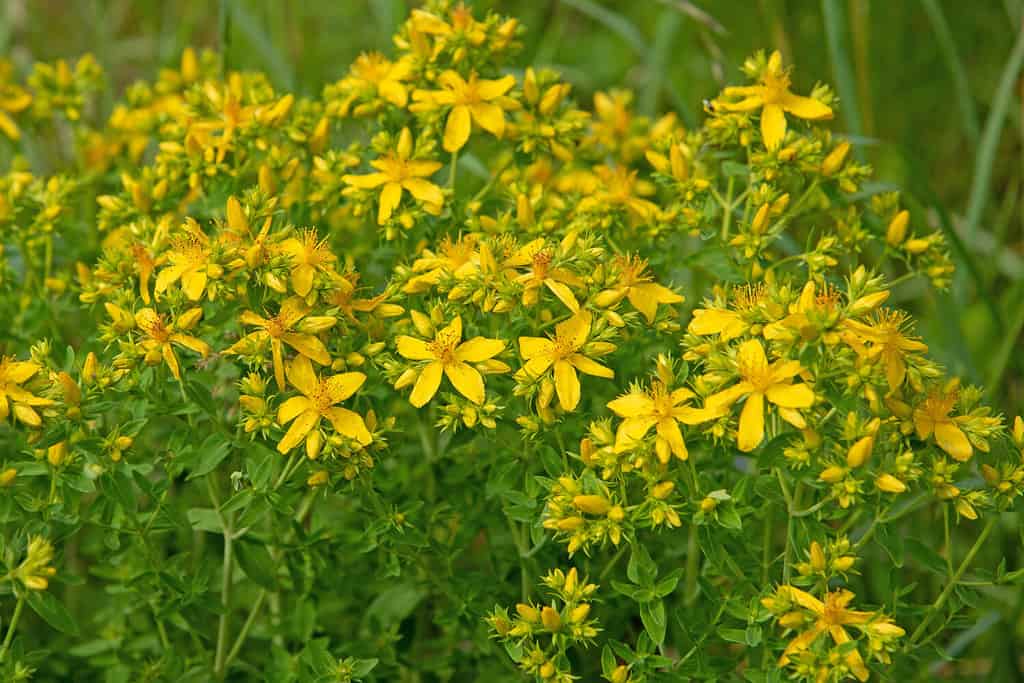
Shrubby St. John’s wort can tolerate a number of adverse conditions.
©M. Schuppich/Shutterstock.com
Another North American native, this deciduous shrub grows from 1 to 5 feet tall and has a 1 to 4 foot spread. A tough plant, it can tolerate periods of drought, rocky ground, and heavy, clayey soils. It can even be planted near black walnut trees, which usually poison most things planted near them. Shrubby St. Johnswort is prized for its beautiful, sunny yellow flowers, which have five petals, are about an inch around, and have delightfully bushy stamens. These stamens give the shrub its species name prolificum, because they’re so prolific.
Shrubby St. Johnswort likes partial shade and needs only a medium amount of watering. It’s pretty much pest and disease-free and easy to grow and maintain. It works wonderfully as a hedge.
9. Japanese Kerria
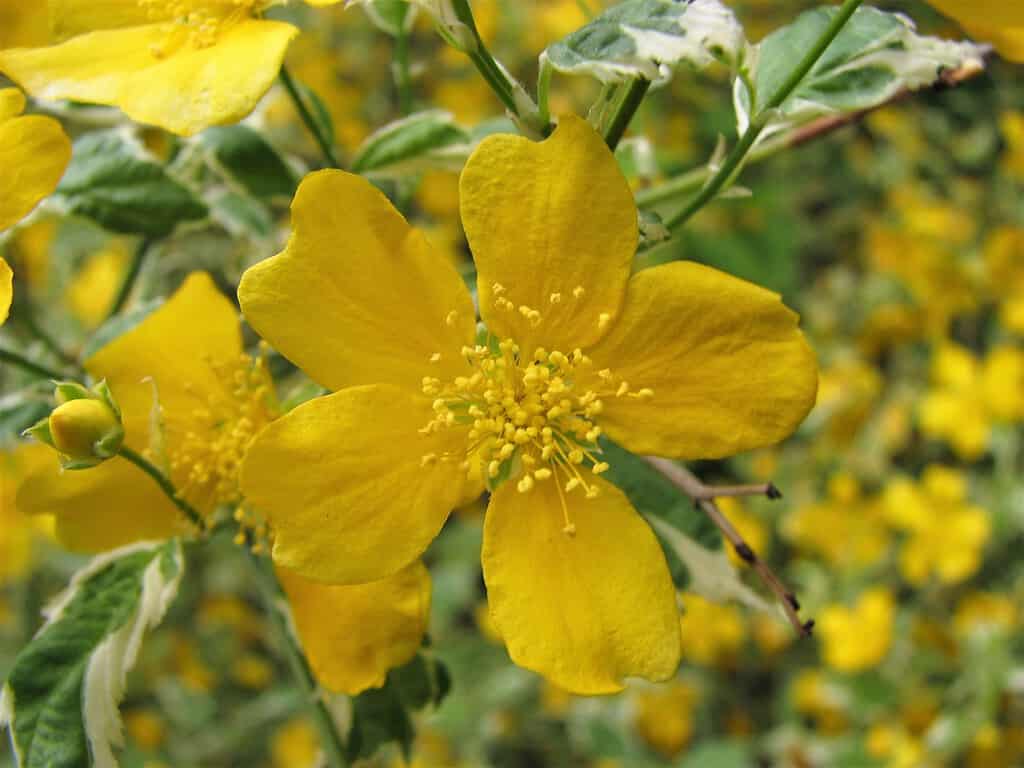
Japanese kerria is the perfect shrub for shade gardens.
©Agnieszka Kwiecień, Nova, CC BY-SA 4.0 <https://creativecommons.org/licenses/by-sa/4.0>, via Wikimedia Commons – Original / License
This beautiful shrub produces a profusion of bright yellow flowers in the spring on arching green stems among narrow, toothed, 4 inch long leaves of bright green. The leaves turn yellow in autumn. The kerria makes an excellent hedge and woodland garden shrub.
The kerria grows from 5 to 10 feet tall with a 10 foot spread. It flourishes in fertile, well-drained soil though it can tolerate soil that is dry or wet. It is an excellent plant for shade gardens, for it loves partial and even full shade. Too much sun causes the flowers, which look like small golden roses, to quickly fade. It needs medium watering and maintenance. Make sure to remove suckers whenever you see them, and don’t over-fertilize.
The photo featured at the top of this post is © Mariia Romanyk/Shutterstock.com
Thank you for reading! Have some feedback for us? Contact the AZ Animals editorial team.







